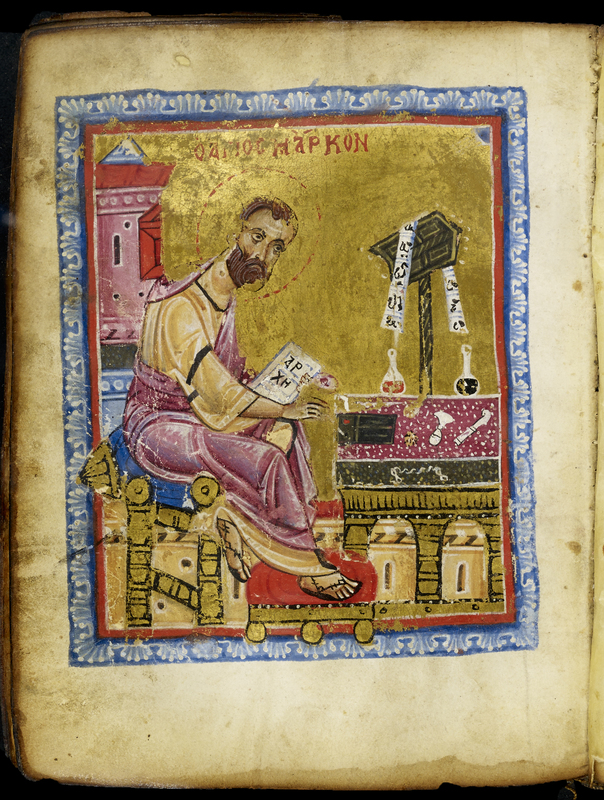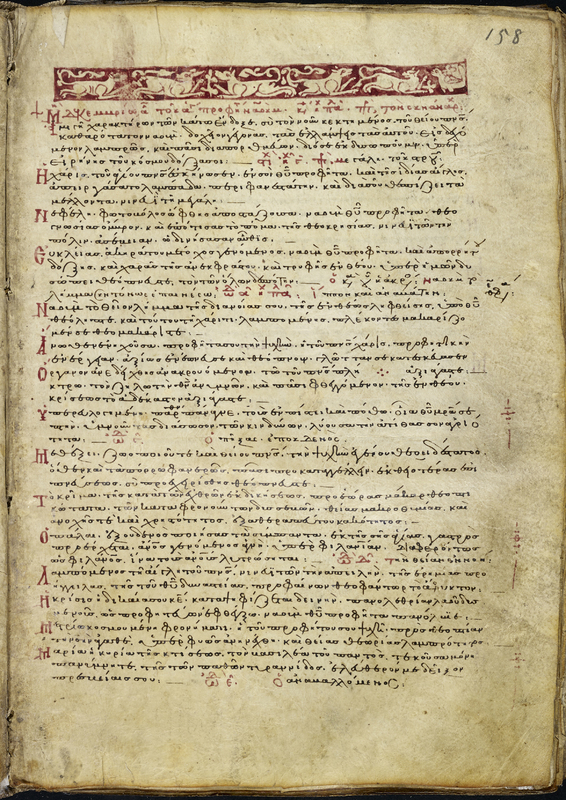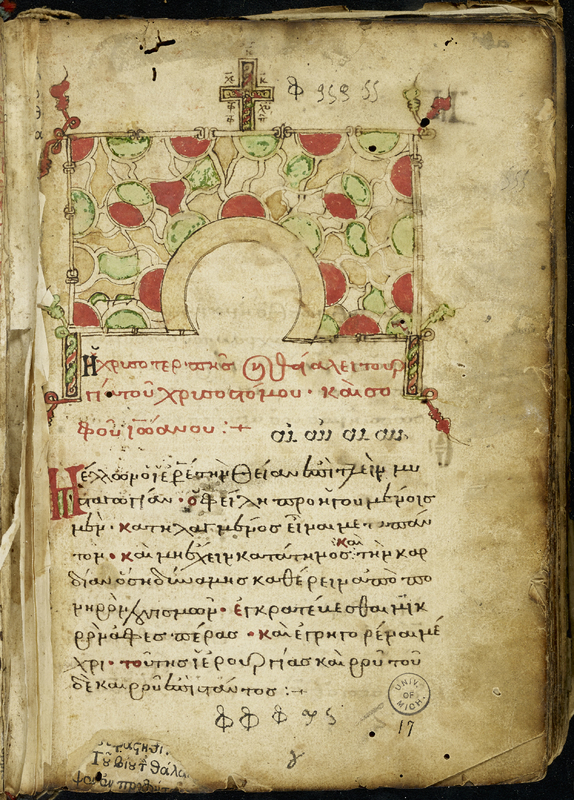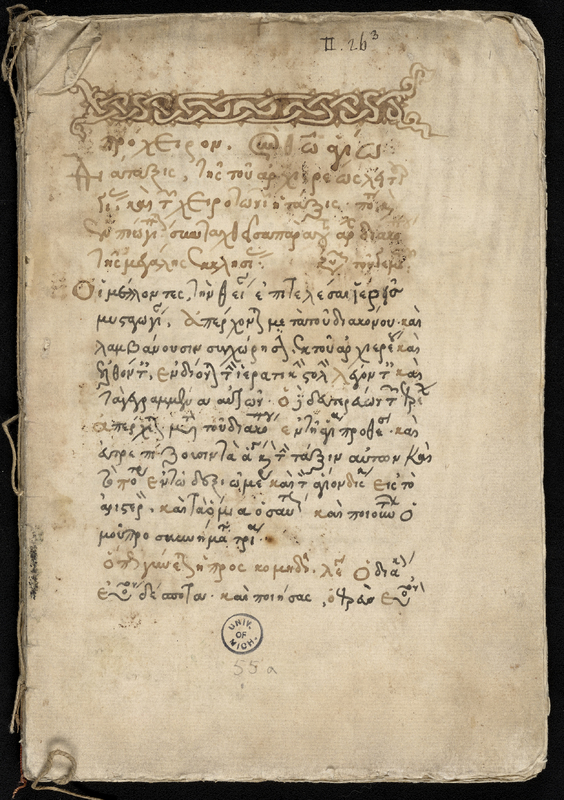The Liturgy
The liturgy of the Christian Church comprises a series of services designed to memorialize the presence and actions of Christ as told in the New Testament. Each of these services was conducted by a minister (bishop or presbyter) and announced by a deacon who regulated the ritualistic components according to certain rules.
Liturgical ceremonies could include both fixed and variable features. The so-called "ordinary" consists of the basic textual foundation that remains the same regardless of the day, feast, or season. Conversely, the "proper" contains a selection of texts that vary according to the day, feast, or season. In Byzantium, the word "liturgy" designates the ritual of the Eucharist, articulated by two formularies consisting of 19 prayers each, which were attributed to Basil the Great (ca. 329-379) and John Chrysostom (ca. 340-407) respectively.
The texts of the "proper" appear in various liturgical books like the Gospel Lectionary (Mich. Ms. 7), Panegyrikon (Mich. Ms. 45), and Menaion (Mich. Ms. 8). The texts of the "ordinary"or unchangable part, are included in books such as the Euchologion (Mich. Ms. 17) and Archieratikon (Mich. Ms. 55a).
In the image above, fol. 8r from Mich. Ms. 7, note the large epsilon on the bottom of the page, one of seven major initials throughout this fragment; they were executed in gold over magenta ink and highly ornamented. In the top margins are lection notes indicating on which Sunday and Saturday the lections should be read. Our eight-leaf parchment fragment contains readings from the Gospel of Luke for Sunday (Luke 10:35) and Saturday (Luke 13:22) only. Throughout this page, and the rest of the fragment, there is Ekphonetic notation in magenta ink, which indicates how the text should be chanted. The script is highly professional, a liturgical Perlschrift (Pearl Script) with a slight inclination to the right. The letters are large, widely spaced, and rounded. The lection titles were written in gold over magenta ink in Alexandrian majuscules (the shape, or volume, of the letters varies between wide and narrow).
A lectionary is a book containing a selection of readings (lections) intended for various religious services. While the lections for the Eucharist are drawn from the Bible, for other services the readings are selected from hagiographic and patristic writings. Most lectionaries include a list of the feasts of the Church calendar along with their relevant lections.
The writing style points to the second half of the eleventh century as the most likely date of execution. The high quality of the parchment, elegant calligraphy, and finely executed initials, suggest Constantinople as the place of production. The fragment was purchased in Constantinople by Francis Kelsey during the University of Michigan first expedition in December 1919.
The image above shows fol. 112r from Mich. Ms. 45; note the headpiece opening the ninth homily by Basil of Caesarea; see the heart-shaped palmette on the top of the headpiece, and the interlace design of the intial pi. The script is executed in large, clear, vertical, and rounded minuscules. The headpieces, initials, and titles of the homilies in Alexandrian majuscules are all written in the same ink as the text, very probably by the scribe himself. The ornamental motifs that we see in this manscript are similar to those present in manuscripts executed in the tenth century: interlace, heart-shaped palmettes, and fret-saw design.
Broadly speaking, a Panegyricon is a liturgical book consisting of homilies (sermons) by the Fathers of the Church (Basil of Caesarea, Gregory of Nyssa, and others) on religious feasts. Our Panegyrikon was very probably executed in the middle or the third quarter of the tenth century, possibly in Constantinople, where manuscripts of similar writing style were produced. In the seventeenth century, two paper quires were added. The manuscript belonged to Baroness Burdett-Coutts. It was acquired by the University of Michigan at the Burdett-Coutts sale in May 1922. Sotheby, Wilkinson and Hodge, The Burdett Coutts Library, lot 213.
Above is fol. 158r from Mich. Ms. 8. Note the headpiece for the month of December, which depicts five small animals — a rabbit chased by four dogs — and a small bird. This scene is strikingly similar to those depicted on the thirteenth-century silver trays produced in the Middle East during the Ayyubid dynasty (late twelfth to mid-thirteenth century). In general, the decoration of Mich. Ms. 8 consists of two rectangular headpieces. They were executed in hollow style on a magenta background. Moreover, there are narrow interlace bands and plain wavy division bars with finials, both in magenta ink, throughout the manuscript.
A complete Menaion is a set of twelve liturgical books, one for each month of the year, containing hymns and other texts relevant for the evening (vespers) and daybreak (matins) services of each feast that falls on a fixed date of the Church calendar. Our manuscript only contains the Menaion for September, October, November, and December.
Two scribes were responsible for copying this manuscript. Scribe I executed most of the manuscript, displaying two distinctive writing styles. One is small-sized, upright, early archaizing script, which imitates Perlschrift but incorporates elements of the thirteenth-century script. The other style is a larger and more energetic cursive, exclusively used for the Synaxarion (index to the lections) to help a reader find the texts. In the fourteenth century, Scribe II wrote on folios inserted from a different manuscript (96rv- and 106r-112v), whose original text was erased (palimpsest). The script is archaizing minuscule, small sized, and vertical.
The script of this manuscript is similar to the one in cod. Holkham gr. 64 (Bodleian Library, Oxford), which was executed by the scribe Gregorios in 1228. In addition, the similarity of the decorative motifs in our manuscript to those of contemporary silver trays executed in the Middle East points to Syria or Palestine as the region where the manuscript was produced. The manuscript was purchased in Constantinople by Francis Kelsey during the University of Michigan first expedition in December 1919.
See above an image of fol. 1r from Mich. Ms. 17. Note the opening headpiece of the Euchologion, a pyle-type headpiece (like a gateway or archway) executed in bright red, green, and yellow. At the top of the headpiece is a cross, the main area is filled with abstract patterns, and double-winged finials are at the corners.
There are many narrow headbands throughout the manuscript, often flanked with tall double-winged finials. The script of this manuscript is an archaizing minuscule, medium sized and vertical.
An Euchologion like Mich. Ms. 17 is a prayer book of the “ordinary” or invariable part of the liturgy, being used for all the services of the Byzantine rite, such as the sacraments, the hours, and various feasts through the ecclesiastical calendar.
See above fol. 107v from Mich. Ms. 17. Note the green and red knotted division bars for the readings of the Holy Week and the epsilon decorated with a blessing hand.
Mich. Ms. 17 was copied at the end of the 14th or beginning of the 15th century. The decoration of the manuscript is Epirotan. Thus, it was produced almost certainly in Epiros and was probably the property of a monastery in this region.
Eventually, it belonged to Baroness Burdett-Coutts (no. III. 29 in her collection). It was acquired by the University of Michigan at the Burdett-Coutts sale in May 1922. Sotheby, Wilkinson and Hodge, The Burdett Coutts Library, lot 173.
In the image above is fol. 1r from Mich. Ms. 55a. The extant decoration of this fragment includes a narrow interlace headband as seen above. There are also interlace or knotted division bars. All of these decorative pieces were executed in light brown ink. Major initials were decorated in floral shapes also in light brown ink. The script is the so-called Gebrauchsschrift, that is, the ordinary monastic cursive.
An Archieratikon is a liturgical book used by the bishop to perform hierarchical services such as the ordination to various ecclesiastical ranks. The extant pages of Mich. Ms. 55a includes a fragment of the Archieratikon, followed by three distinctive services for the ordination of readers, subdeacons, and a deacon, respectively.
The manuscript was probably copied in a provincial monastery. The fragment belonged to Baroness Burdett-Coutts (no. II. 26.3 in her collection). It was acquired by the University of Michigan at the Burdett-Coutts sale in May 1922. Sotheby, Wilkinson and Hodge, The Burdett Coutts Library, lot 223.

The New Testament

The Saints






